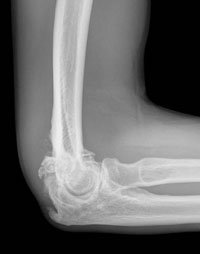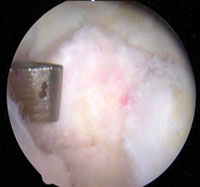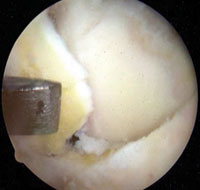Arthroscopic treatment for elbow arthritis: Osteophyte removal helps regain elbow function
Click Here to Manage Email Alerts
Degenerative arthritis of the elbow can cause substantial disability. Although often managed nonoperatively, on presentation symptoms often persist. Such conditions have historically been surgically managed using open techniques. More recently, arthroscopic management has become a more common treatment modality with results comparable to or even better than similar open procedures. Arthroscopic assessment of the arthritic elbow enables the surgeon to comprehensively evaluate for and thoroughly treat pathology in both the anterior and posterior elbow joint compartments while significantly reducing the iatrogenic insult when compared to an open surgical approach.
Therefore, arthroscopic debridement for patients with symptomatic degenerative arthritis is a reliable and effective procedure.
History, physical exam, imaging
Primary osteoarthritis of the elbow often occurs in manual laborers, athletes and others whose activities place excessive stress on the elbow joint. Symptoms include motion loss, mechanical catching and locking and pain. Physical examination reveals crepitation, abnormal movement patterns and a decreased arc of motion.
Careful preoperative evaluation of the ulnar nerve is important. Confirmation of the location of the ulnar nerve within its groove helps reduce risk of intraoperative nerve injury. Also, preoperative recognition of any ulnar nerve symptoms is key; as such symptoms are common in these patients and are prone to worsen after surgical treatment as a consequence of postoperative gains in elbow motion. Also, patients with dramatic limitations in preoperative motion should be considered for prophylactic, concurrent decompression of the ulnar nerve, even in the absence of preoperative symptoms, due to the potential for the development of postoperative ulnar nerve problems.
|
|
Images: Field LD |
Plain radiographs typically demonstrate hypertrophic bone spurs and loose bodies (Figure 1). CT scans are often very useful, particularly when 3-D CT reconstructions are also obtained. These 3-D CT scan images accurately define the bony architecture and help in preoperative planning (Figure 2).
Standard arthroscopic equipment
Standard arthroscopic equipment, including a 4-mm 30° arthroscope and interchangeable arthroscopic cannulas, are utilized. Generally, following confirmation of the location of the ulnar nerve in its groove and insufflation of the joint, proximal anterior portals are established with the patient in the prone or lateral decubitus position. Arthroscopic evaluation of the anterior compartment typically reveals a large coronoid process osteophyte and loose bodies. The coronoid fossa on the anterior humerus also usually demonstrates osteophytic bone formation. Arthroscopic debridement with recontouring of the coronoid fossa along with resection of coronoid process osteophytes and loose body removal is performed. In cases of very significant motion loss, release of the anterior capsule from its origin on the humerus can be completed as well.
|
|
Arthroscopic radial head excision may be necessary in some patients with significant radiocapitellar symptoms. Excision of the radial head can begin with the arthroscopic burr in the anterolateral portal allowing resection of the anterior portion of the radial head. The radial head excision can then be completed via a posterior soft spot portal.
Arthroscopic evaluation and management of the posterior elbow compartment is carried out next. Arthroscopic visualization typically demonstrates large olecranon process osteophytes and exuberant bone formation within the olecranon fossa. Likewise, large osteophytes are usually seen in the posteromedial and posterolateral gutters of the elbow joint as well. Following debridement of soft tissue and removal of any loose bodies, resection of the olecranon process and olecranon fossa osteophytes can begin. Three-dimensional CT scans are often helpful in correlating the arthroscopic view with the radiographic view and can be a valuable aid in accurately determining the amount and location of bone to resect.
Small osteotomes (Figure 3) are also valuable tools allowing effective olecranon process (Figure 4) and gutter osteophyte resection while reducing the potential for iatrogenic injury to the articular cartilage and neurovascular structures in this congruent joint. In addition, fenestration of the olecranon fossa can be a helpful adjunct by enhancing not only olecranon fossa debridement, but also coronoid fossa debridement. Finally, if indicated, ulnar nerve decompression is performed either arthroscopically or using an open technique.
|
|
|
Postoperative considerations
Following completion of the arthroscopic procedure, the elbow is assessed in the operating room to ensure restoration of motion. Radiographs or fluoroscopy may be used to confirm adequate osteophyte resection and the absence of any additional loose bodies. Range of motion exercises are typically begun on the first postoperative day with no limitations or restrictions imposed. Heterotopic ossification prophylaxis also may be considered, particularly in patients with hypertrophic osteophyte formation, as postoperative ectopic bone formation is a rare but serious complication.
Preoperative assessment of the ulnar nerve with consideration given to possible ulnar nerve decompression at the time of elbow surgery is emphasized. Also, preoperative examination utilizing 3-D CT scan reconstructions is helpful to identify and define the osteophytes to be resected at the time of surgery. Finally, utilizing small osteotomes to accomplish arthroscopic resection of osteophytes should be considered.
References:
- Adams JE, Wolff LH, Merten SM, Steinmann SP. Osteoarthritis of the elbow: results of arthroscopic osteophyte resection and capsulectomy. J Shoulder Elbow Surg. 2008;17(1): 126-131.
- Antuna SA, Morrey BF, Adams RA, O’Driscoll SW. Ulnohumeral arthroplasty for primary degenerative arthritis of the elbow: long term outcome and complications. J Bone Joint Surg Am. 2002;84(2); 2168-2173.
- Savoie FH, Nunley PD, Field LD. Arthroscopic management of the arthritic elbow: indications, technique, and results. J Shoulder Elbow Surg. 1999;8(3):214-219.
- Savoie FH, O’Brien MJ, Field LD. Arthroscopy for arthritis of the elbow. Hand Clin. 2011;27(2):171-178.
- Steinmann SP, King GJ, Savoie FH. Arthroscopic treatment of the elbow arthritis. J Bone Joint Surg Am. 2005;87(9):2114-2121.

- Larry D. Field, MD, is Director, Upper Extremity Service, and P. Matt Kamien, MD, is a fellow at Mississippi Sports Medicine and Orthopaedic Center, 1325 East Fortification St., Jackson, MS 39202. Field can be reached at email: lfield@msmoc.com. Kamien can be reached at email: mattkamien@gmail.com.
- Disclosures: Field and Kamien have no relevant financial disclosures.





